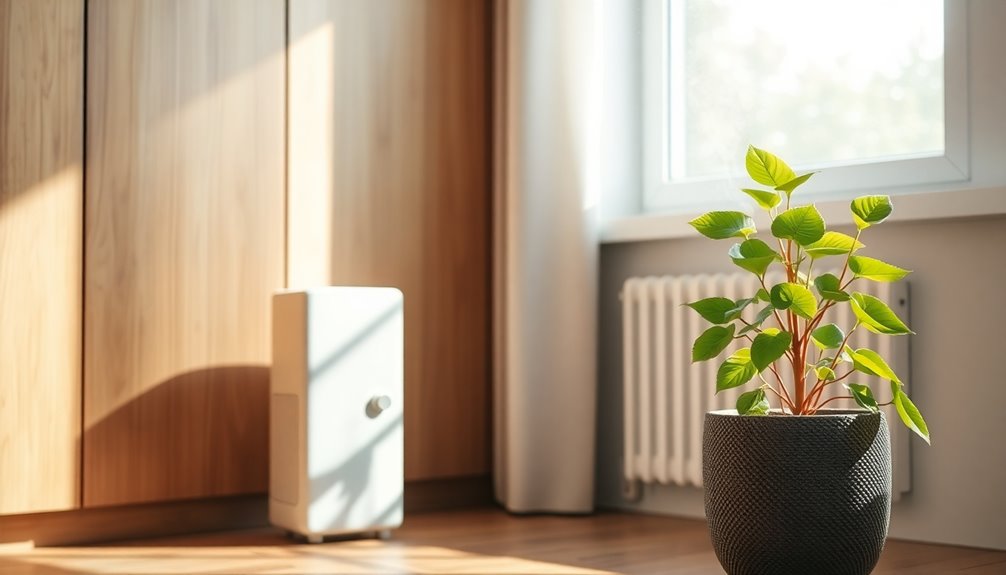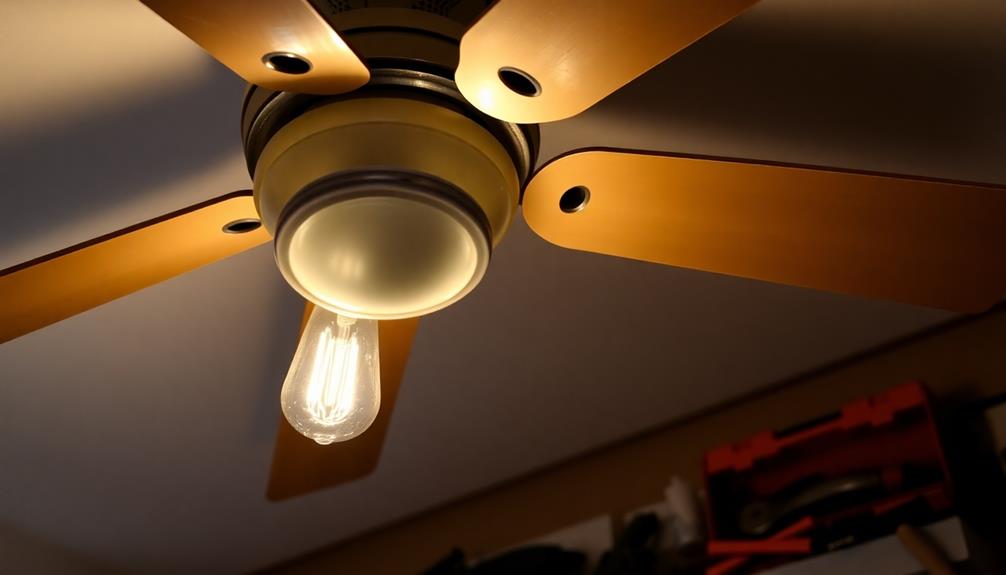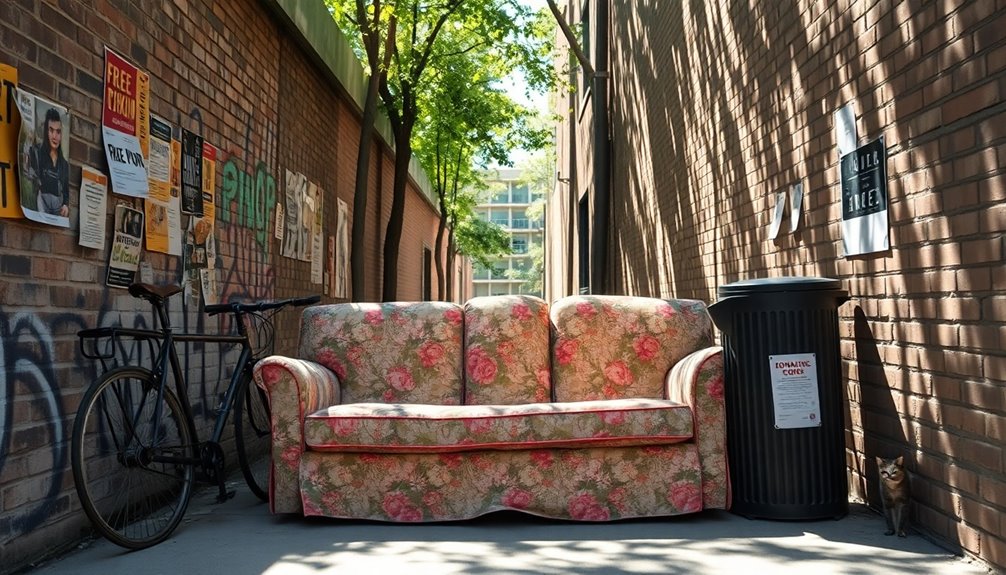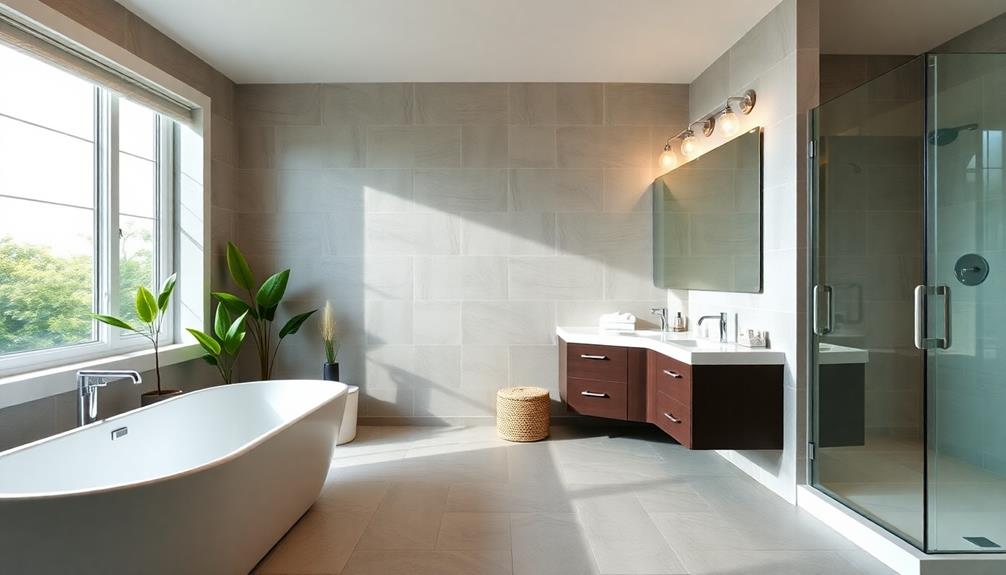To remove formaldehyde from furniture, start by improving ventilation in your space. Open windows and use exhaust fans to circulate fresh air. Consider using air purifiers with activated carbon filters, as they effectively reduce airborne formaldehyde. You can also apply non-toxic sealants to particleboard furniture to lock in emissions. Incorporating plants like Boston ferns or using activated charcoal can help absorb pollutants naturally. Lastly, opt for solid wood or bamboo furniture over pressed-wood products in the future. If you’re interested in more detailed methods and tips, there’s plenty more to explore beyond these basics. Additionally, maintaining a clean and dry environment can significantly reduce the presence of harmful substances, including formaldehyde. Regularly dusting and vacuuming helps to minimize the accumulation of airborne particles. If you’re also concerned about pests, such as termites, you might want to look into how to eliminate termites in furniture, as they can cause hidden damage over time. Implementing these strategies will not only lead to a healthier indoor atmosphere but also prolong the lifespan of your furniture.
Key Takeaways
- Allow new furniture to off-gas in a well-ventilated area by opening windows and using exhaust fans to reduce formaldehyde levels.
- Use air purifiers with activated carbon filters to effectively capture and reduce formaldehyde and other volatile organic compounds.
- Seal particleboard furniture edges with non-toxic sealants or apply eco-friendly low-VOC coatings to minimize emissions.
- Incorporate houseplants like Boston ferns or English Ivy that naturally absorb formaldehyde and improve indoor air quality.
- Regularly monitor indoor air quality with sensors and conduct professional assessments to ensure formaldehyde levels remain safe.
Understanding Formaldehyde Emissions

Formaldehyde emissions are a critical concern when it comes to furniture and household items. You'll often find this chemical used in the production of particle boards, plywood, and medium-density fiberboard (MDF) products. It's also present in upholstery, carpets, and paints, making it a common household exposure. Composite wood products, in particular, are significant sources of formaldehyde emissions in furniture, as it acts as both a preservative and adhesive.
Several factors affect the level of formaldehyde emissions. For instance, high humidity and rising temperatures can accelerate the release of formaldehyde gases, especially in tightly sealed spaces. You might notice that new furniture emits more formaldehyde initially, with emissions decreasing over time. The materials and adhesives used in furniture construction play a crucial role in determining emission levels. Recent evaluations have shown that formaldehyde poses unreasonable health risks, indicating the importance of monitoring these emissions closely.
Regulatory standards exist to manage these emissions. The U.S. EPA, California Air Resources Board, and the European Union all set specific limits to protect your health. Certifications like GREENGUARD and CARB indicate products with lower emissions. By understanding these emissions, you can make informed decisions about the furniture and items you bring into your home.
Importance of Ventilation

To effectively reduce formaldehyde concentrations in your home, proper ventilation plays a crucial role. By opening windows and doors, you allow fresh air to circulate, which helps dilute formaldehyde levels. This natural ventilation technique is especially beneficial in environments with low to moderate formaldehyde levels and good outdoor air quality. Make it a habit to regularly open windows, particularly after bringing in new furniture or painting, to disperse any accumulated formaldehyde.
Cross-ventilation enhances this effect by promoting the exchange of indoor and outdoor air, further decreasing pollutant levels. If natural ventilation isn't feasible, consider mechanical systems like exhaust fans or air handling units. These systems effectively introduce fresh air while removing contaminated air, ensuring a consistent exchange even in tightly sealed buildings.
Control temperature and humidity to enhance ventilation's effectiveness. High humidity can accelerate formaldehyde emissions, so using air conditioners or dehumidifiers helps maintain indoor humidity between 30-50%. Cooler temperatures also slow down off-gassing. By focusing on these ventilation strategies, you can significantly improve your indoor air quality and create a healthier living environment. Additionally, it is essential to be aware that prolonged formaldehyde exposure can lead to serious health issues, making effective ventilation even more critical in maintaining a safe home atmosphere.
Utilizing Air Purifiers

When looking to reduce formaldehyde levels in your home, utilizing air purifiers equipped with activated carbon filters can be highly effective. Activated carbon acts as a universal adsorbent, capturing formaldehyde and other harmful gases through its tiny pores. Keep in mind that HEPA filters alone won't remove gaseous pollutants effectively, so ensure your air purifier has that essential activated carbon filter. Studies have shown that some models can remove up to 90% of formaldehyde from the air, enhancing your indoor environment.
To maximize effectiveness, check the Clean Air Delivery Rate (CADR) of the purifier. A higher CADR value means it can clean more air in a given time, which is crucial for formaldehyde removal. For larger rooms, you might need a more powerful unit or multiple purifiers to ensure proper airflow and circulation.
Remember that activated carbon filters have a limited lifespan. Regular maintenance, including timely replacement, is vital to maintain their effectiveness. If these filters become saturated or exposed to heat and moisture, they could release formaldehyde back into the air. So, keep an eye on your filters and dispose of them properly to avoid further pollution. By taking these steps, you can significantly improve your indoor air quality.
Sealing and Coating Techniques

Sealing and coating your furniture effectively can significantly minimize formaldehyde emissions in your home. Start by using water-based commercial sealers specifically designed to lock in these harmful emissions. Ensure you apply the sealant to all exposed surfaces, including edges and undersides, and always follow the manufacturer's instructions for application and drying times. Reapply periodically, especially in high-use areas, as sealants can degrade over time.
You can also consider traditional finishes like varnish, shellac, or lacquer, which serve as effective sealants. Apply these finishes evenly and thoroughly to all surfaces to prevent formaldehyde from escaping. Make sure the finish is fully dry before using the furniture, and consider multiple coats for enhanced protection. Additionally, MDF construction often leads to higher emissions, so special attention to sealing is vital.
If you prefer eco-friendly options, choose low-VOC paints or coatings designed to reduce formaldehyde emissions. Apply a layer before using new wooden furniture and let it air out in a well-ventilated area until dry. For fabrics, specialized sprays can create a barrier against formaldehyde. Always follow application instructions and reapply as needed to maintain effectiveness. These sealing and coating techniques can make a noticeable difference in your indoor air quality.
Natural Absorption Methods

Natural absorption methods offer effective solutions for reducing formaldehyde levels in your home. One of the easiest ways to tackle this is by using houseplants. Plants like Boston ferns, English Ivy, and Spider Plants naturally absorb formaldehyde from the air, helping to purify your space. Create a "green corner" by grouping several plants together for enhanced air purification. Low-maintenance options like Monstera and Aloe Vera also work well. Additionally, solid wood furniture does not typically contain formaldehyde, making it a safer choice for your home.
Another great option is activated charcoal. Place bowls or bags of activated charcoal near your furniture to absorb odors and VOCs. Just remember, charcoal needs exposure to air, so don't seal it in airtight bags.
White vinegar is another natural absorber; setting out bowls of white vinegar can help eliminate formaldehyde smells from your furniture. You can even add vinegar to laundry cycles to neutralize formaldehyde in fabrics.
Lastly, consider using baking soda. Sprinkling baking soda on fabrics and letting it sit for an hour can effectively neutralize odors. It bonds with VOCs, making it a safe and natural choice. By incorporating these methods, you can create a healthier environment in your home.
Heating and Ventilation Strategies

Effective heating and ventilation strategies can significantly reduce formaldehyde levels in your home. Start by opening windows and doors to let fresh air circulate and dilute indoor concentrations. For better results, create cross-ventilation by opening windows and doors on opposite sides of the room.
Make sure to use exhaust fans in kitchens, bathrooms, and laundry rooms to expel contaminated air directly outside. Keep these fans running during and after any renovations to continuously remove pollutants. Additionally, consider installing mechanical ventilation systems like heat recovery ventilators (HRV) or energy recovery ventilators (ERV) to enhance air exchange without losing energy efficiency.
To accelerate off-gassing from new furniture, use the "Cookout Method" by heating the space to 30-40°C for several hours while ensuring proper ventilation. This method helps reduce long-term formaldehyde emissions. Consistent ventilation is essential, especially in the first few weeks post-renovation, to maintain lower indoor levels of this harmful substance. Monitor temperature and ventilation carefully during this process to prevent safety hazards.
Maintenance Practices for Furniture

Maintaining your furniture is crucial in minimizing formaldehyde emissions and ensuring a healthier living environment. Start by sealing exposed edges of particleboard or pressed wood furniture with non-toxic sealants like water-based polyurethane. This prevents the release of harmful gases. Additionally, treat all surfaces, including undersides, with these sealants to enhance their effectiveness.
Using air purifiers with activated carbon filters can significantly reduce VOC levels in your home. Keep these purifiers running continuously, especially in rooms with new furniture. If you want extra protection, consider models with photocatalytic oxidation technology.
For fabric furniture, regular cleaning is key. Wash new upholstery and curtains with hot water and mild detergent to help remove residual formaldehyde. Adding baking soda or vinegar during washing can further neutralize odors. Air-drying fabric items in sunlight not only freshens them but also utilizes UV rays to break down formaldehyde. Additionally, using effective ventilation techniques can help reduce formaldehyde levels even further by promoting air circulation.
Finally, incorporate natural absorbents like activated charcoal or houseplants such as peace lilies and spider plants. These can effectively reduce VOCs. Using a formaldehyde detector will help you monitor emission levels, ensuring your maintenance practices are working effectively.
Choosing Safe Furniture Options

Choosing Safe Furniture Options
When selecting furniture, prioritizing safe materials can significantly reduce your exposure to formaldehyde and other harmful chemicals. Start by choosing solid wood or bamboo furniture, as both are natural, durable, and low in formaldehyde. Metal and glass pieces are also excellent options since they don't off-gas harmful substances and are easy to maintain.
Avoid pressed-wood products like particleboard, plywood, and MDF, which often contain formaldehyde glues. Upholstered furniture and laminate flooring can also harbor high levels of formaldehyde, so steer clear of these. Be cautious of cheap furniture made from composite materials that may be loaded with chemicals. Additionally, natural remedies can help mitigate exposure to indoor air pollutants.
Look for certifications and labels that indicate safety, such as GREENGUARD Gold, Global Organic Textile Standard (GOTS), and Global Organic Latex Standard (GOLS). These labels assure you of low VOC emissions, including formaldehyde. Additionally, brands like IKEA, Medley, Urban Natural, Viesso, and Purebond Plywood offer safer options that meet stringent standards. By making informed choices, you can create a healthier living environment free from harmful chemicals. Solid wood is recommended as a preferred material for its low off-gassing compared to alternatives.
Professional Removal Services

Professional removal services can provide a comprehensive solution for eliminating formaldehyde from your home. They begin with an initial assessment, conducting indoor air quality tests to determine formaldehyde levels using specialized monitors like RAE® VOC and HCHO Monitors. Based on the results, they customize a treatment plan tailored to your specific needs, identifying sources of formaldehyde emissions, such as new furniture or recent renovations.
Using advanced equipment, these professionals employ air purifiers with specialized filters designed to trap and neutralize formaldehyde molecules. They also utilize axial fan ventilation kits for thorough air washing and Miele Allergy Vacuum Cleaners for vacuuming wood furniture. Space fogging with SafePRO® Formaldehyde & Odour Remover further enhances the treatment. Moreover, since high concentrations of formaldehyde can cause irritation to eyes, it is crucial to address these levels promptly.
After deep cleaning and applying natural fragrance gels to purify the air, they seal exposed edges of particleboard furniture with non-toxic sealants. Finally, they'll conduct tests to ensure a significant reduction in formaldehyde levels and provide you with a complimentary Formaldehyde and VOCs Test Report. You'll enjoy the benefits of improved indoor air quality, leading to a healthier living environment.
Monitoring Indoor Air Quality

To effectively monitor indoor air quality, you can utilize sensors that detect pollutants like formaldehyde. Place these sensors strategically throughout your space; the EPA recommends one sensor for every 10,000 square feet for reliable results. Advanced sensors measure various pollutants, including carbon monoxide, particulate matter, and volatile organic compounds (VOCs), providing real-time data on emission levels. Additionally, understanding the impact of poor indoor air quality on health can motivate you to take action in monitoring and improving your environment.
In addition to sensors, consider investing in high-quality air purifiers equipped with activated carbon filters. These filters can reduce VOC levels by up to 80%, continuously improving your indoor air quality. Position air purifiers in areas where formaldehyde emissions are highest, and use them alongside proper ventilation for maximum effectiveness.
Implementing good ventilation is the simplest way to minimize formaldehyde buildup. Place new furniture in well-ventilated spaces or near open windows to facilitate off-gassing. You can also use fans to enhance airflow and direct emissions away from your living areas. Let new furniture air out in a garage or outdoor area for a few days before bringing it indoors. By combining these methods, you can effectively monitor and improve your indoor air quality.
Frequently Asked Questions
How Long Does Formaldehyde Off-Gassing Typically Last?
Formaldehyde off-gassing can last anywhere from a few months to several years, depending on various factors. You'll notice the highest intensity right after you unpack your furniture. Typically, some items may off-gas fully within a year, while others continue for up to five years or longer. Keep in mind that larger pieces or those made from materials like plywood and MDF tend to off-gas for a longer duration.
Can I Use Essential Oils to Mask Formaldehyde Odors?
You can use essential oils to temporarily mask formaldehyde odors, but don't expect a permanent solution. Oils like citrus, eucalyptus, and thyme have strong scents that might help for a while. However, keep in mind these oils can sometimes contain formaldehyde themselves or worsen indoor air quality. Instead of just masking the smell, focus on improving ventilation and using effective removal methods to tackle the underlying issue of formaldehyde exposure.
Is Formaldehyde Exposure Harmful to Pets?
Yes, formaldehyde exposure can be harmful to pets. It can lead to serious health issues, including respiratory distress, skin irritation, and even cancer. You might notice symptoms like excessive drooling, vomiting, or shallow breathing if your pet's been exposed. Prolonged exposure can also result in neurotoxic effects and chronic health problems. To keep your furry friend safe, it's crucial to minimize their exposure to items containing formaldehyde, especially in enclosed spaces.
What Symptoms Indicate Formaldehyde Sensitivity?
If you're experiencing symptoms of formaldehyde sensitivity, you might notice skin reactions like redness, itching, or swelling. Respiratory issues, such as coughing and a sore throat, can also occur. Additionally, you may deal with eye irritation, including watery or burning sensations. Headaches and nausea can arise too. In severe cases, you could face fatigue, asthma attacks, or even shortness of breath. Keep an eye on these signs to protect your health.
Are There Specific Brands Known for Low-Formaldehyde Furniture?
If you're looking for brands known for low-formaldehyde furniture, consider options like Pottery Barn and West Elm. They offer GREENGUARD Certified products, ensuring low VOC emissions. Burrow Sofas uses formaldehyde-free MDF, while IKEA provides solid wood items without formaldehyde in North America. Brands like Vermont Woods and TY Furniture focus on solid wood with non-toxic finishes. These options can help you create a healthier living environment without compromising on style.
Conclusion
In conclusion, tackling formaldehyde in your furniture doesn't have to be overwhelming. By ensuring proper ventilation, using air purifiers, and applying sealing techniques, you can significantly reduce emissions. Don't forget to explore natural absorption methods and maintain your furniture regularly. When shopping, opt for safer materials to prevent future issues. If you're still concerned, consider professional removal services. Keep a close eye on your indoor air quality, and you'll create a healthier home environment for everyone.









